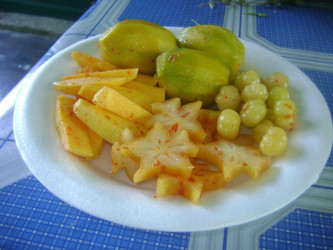By Marilyn Collins
Consumers riding the eat-healthy bandwagon are now displaying an intense interest in nutritious fresh foods including fresh fruit and vegetables, leaves, roots, tubers and flowers. These have become desirable foods, sought after by health conscious consumers. Food service establishments, in response to this health craze, are adding fresh salads—fruit and vegetable—to their menus. On the streets, the sale of fresh-cut fruit and vegetables is mushrooming. However, fresh, ready-to-eat or minimally-processed fruit and vegetables can be a vehicle for the transmission of microorganisms—bacterial (germs), parasitic (worms) and viral pathogens—capable of causing human illnesses.

The literature is replete with instances in which ready-to-eat fruit and vegetables have been implicated in outbreaks of illnesses. Pathogens (disease causing germs) most frequently linked to produce-related outbreaks include bacteria, the likes of Salmonella, E. coli, L. monocytogenes, S. aureus; Norwalk-like viruses and hepatitis A and parasites Cryptosporidium and Cyclospora. In the USA, between 1998 and 2006, lettuce was responsible for 30% of the more than 75% recall of contaminated fresh produce. Other produce recall included cantaloupe, cucumber, tomato and mango.
There are many production practices, growth conditions and the location of the edible part of the fruit or vegetable during growth, soil, soil surface, and aerial part, harvesting and processing factors, that affect the microbial status of fresh produce at the time of consumption. Other factors that have a similar effect have to do with physical and chemical characteristics of the foods as well as storage conditions.
This article will not, however, dwell on the entire farm-to-fork conditions with all of the complex multilevel handling and distribution procedures or the chemical hazards associated with such produce. Rather, it will focus on the hygiene practices that could contribute to microbial contamination of fresh ready-to-eat and minimally processed fruits and vegetables.
It is noteworthy that pH (acidity and alkalinity) an intrinsic parameter that impacts on microbiological safety of many fruits and vegetables that are within the neutral pH range, such as in the case of watermelon, thus could facilitate the proliferation of bacteria. However, pH of 4.0 and below, present a window of safety. Research has shown that bacteria can survive in many juices in which the pH is above 4.0. Care should be exercised by fresh fruits and vegetable vendors to ensure that hygienic practices are observed and that for instance when pickles are replenished, the pH is within the safety level.

Thorough washing of fruit and vegetables can remove much of the adhering soil and dirt. However, washing may also be a source of microbial contamination if the quality of the washing water is questionable.
From a food safety standpoint the wash water should be at reduced temperature – below ambient – to inhibit the growth of microorganisms. Temperature control and reduced temperature in particular, is a pivotal tool for controlling microbial growth and maintaining product quality and safety. Monitoring of organic load (dirt) build should serve as an indicator as to when the water must be refreshed to break the contamination barrier.
Examples of the contamination of fresh produce include the contamination of tomatoes with Salmonella javania and of parsley with Shigella sonnei, which caused large outbreaks. Mangoes were found to infect consumers with Salmonella and the infection was traced to contaminated hot water used to kill fruit flies in the mangoes.
Various types of processing such as cutting, slicing, skinning and shredding remove or damage the protective surfaces of the plant or fruit. There are different consequences for food safety associated with such processing. During washing some microorganisms will be removed from the product, nutrients will become available, and pathogens can be spread from contaminated parts to uncontaminated parts.
It would appear that the acidic properties of some juices do not always prevent the survival of organisms
Consideration should also be extended to the hygienic conditions of the tools such as knives used during processing as well as the personal hygiene practices of the food handler.
Tools used for the processing of fresh fruit and vegetables should be washed and sanitized as necessary. Food handlers should also adhere to hand hygiene practices and the processed fruits and vegetables should not be handled with the bare hands.
The best method of eliminating pathogens is to prevent contamination in the first place. However, this is not always possible and the need for washing fresh produce remains of paramount importance in order to minimize potential risk of food-borne disease outbreaks. Washing is unlikely to completely eliminate pathogens after the produce is contaminated and washing apart, other sanitizing protocols can be applied.
Sanitizing is the process of reducing harmful microorganisms to levels considered safe without adversely affecting either the quality of the product or its safety. The generally accepted order of cleansing events is to rinse, clean, rinse and sanitize. Most sanitizers must be applied to surfaces that are free of organic matter (dirt) and detergent residues. The detergent used in the cleaning step needs to be appropriate for the type of soil or debris present. There is a possibility of some degree of bacterial resistance when some organisms are unaffected by the sanitizing chemical because of biofilm formation. Biofilms are polysaccharides that allow attachment to almost any surface. Bacteria such as Escherichia, Salmonella, E coli, Listeria Campylobacter and several others can produce biofilms.
The task of ensuring that chemical sanitisers are prepared and applied properly to avoid inappropriate residues rests with the food processor, food service operator and monitoring for compliance by the regulator.
The efficacy of a chemical used for sanitizing is based upon its ability to kill food poisoning bacteria.
The first determination is the type and concentration of sanitiser for the task at hand. The sanitisers primarily maintain water quality in the wash systems and prevent possible contamination. Without them, the wash systems would inoculate the entire processed product.
The choices of sanitisers are greatly expanded, including various active oxygen materials such ozone, hydrogen peroxide and peroxyacetic acid. Also available are various sources of chlorine releasing compounds, including gas, sodium hypochlorite, calcium hypochlorite and electrolysis of salt. All of these materials have efficacious antimicrobial characteristics.
This list is not exhaustive but includes the most common.
The key question for a processor is which of these other materials are most effective at ensuring the safety of the produce without decreasing quality parameters. Generally, sodium hypochlorite is the cheapest and most used sanitizer. Every processor should have a clear understanding as to why they have selected a particular sanitizer and what its strengths and limitations are.
Temperature is a key element for controlling microbial growth and maintaining product quality. Accordingly, the temperature for washing and sanitizing process should be below room temperature since it slows the growth of bacteria.
This discussion will not engage in the merits and demerits of testing the final product as a means of determining safety but will note that the growth pattern of microorganism is not homogenous and the unpredictability of sampling could result in inaccurate interpretation of the safety of the produce.
So testing cannot be relied upon solely for the detection of pathogenic organisms and the verification of the safety of the produce. Accordingly, the protection of public health demands that processors of fresh and minimally processed fruits and vegetables be proactive in seeking to safeguard the health of the consumer by observing basic hygiene protocols.





